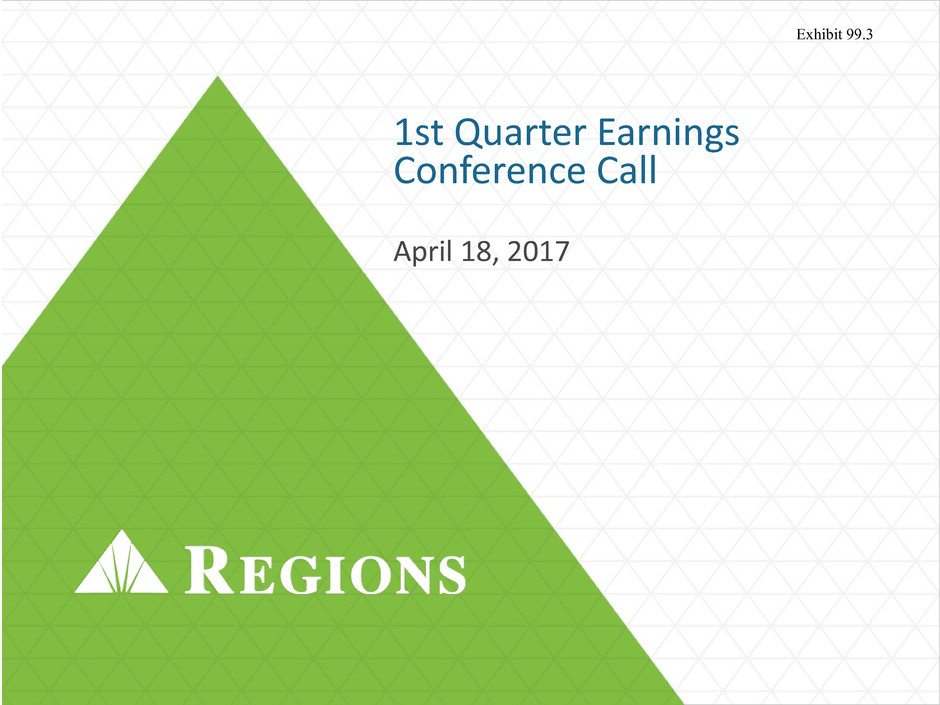
1st Quarter Earnings Conference Call April 18, 2017 Exhibit 99.3
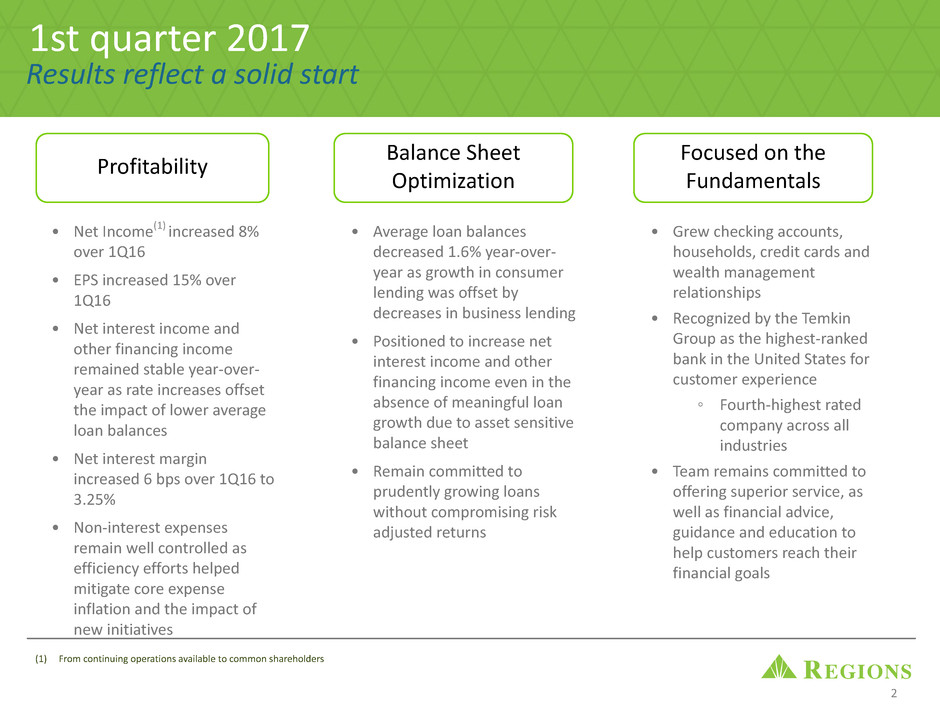
1st quarter 2017 • Net Income(1) increased 8% over 1Q16 • EPS increased 15% over 1Q16 • Net interest income and other financing income remained stable year-over- year as rate increases offset the impact of lower average loan balances • Net interest margin increased 6 bps over 1Q16 to 3.25% • Non-interest expenses remain well controlled as efficiency efforts helped mitigate core expense inflation and the impact of new initiatives (1) From continuing operations available to common shareholders Results reflect a solid start 2 Profitability • Average loan balances decreased 1.6% year-over- year as growth in consumer lending was offset by decreases in business lending • Positioned to increase net interest income and other financing income even in the absence of meaningful loan growth due to asset sensitive balance sheet • Remain committed to prudently growing loans without compromising risk adjusted returns Balance Sheet Optimization • Grew checking accounts, households, credit cards and wealth management relationships • Recognized by the Temkin Group as the highest-ranked bank in the United States for customer experience ◦ Fourth-highest rated company across all industries • Team remains committed to offering superior service, as well as financial advice, guidance and education to help customers reach their financial goals Focused on the Fundamentals
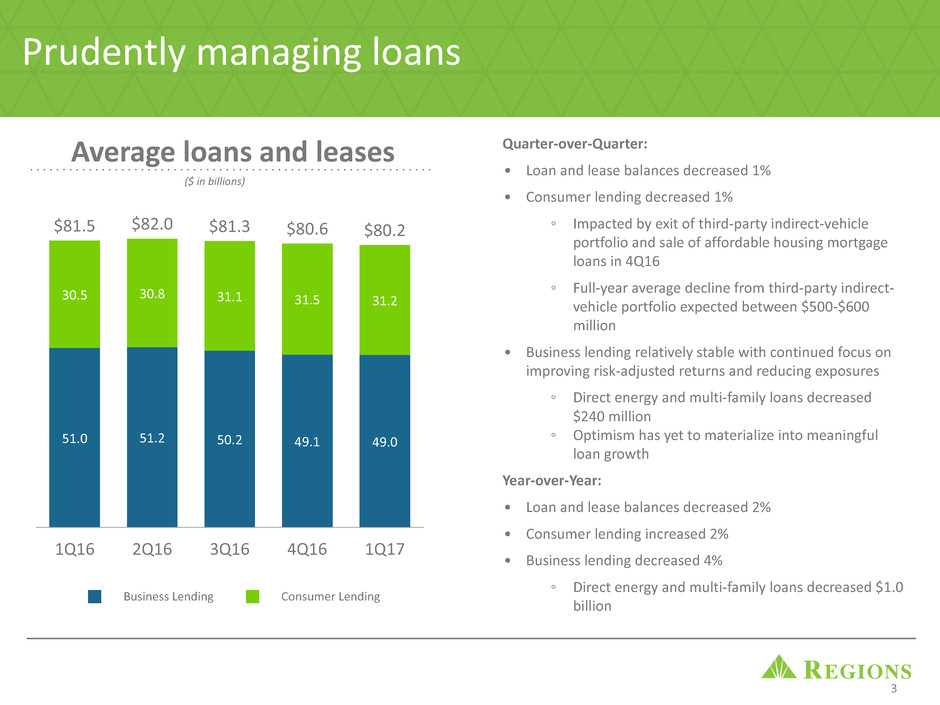
Average loans and leases Business Lending Consumer Lending 1Q16 2Q16 3Q16 4Q16 1Q17 51.0 51.2 50.2 49.1 49.0 30.5 $81.5 30.8 $82.0 31.1 $81.3 31.5 $80.6 31.2 $80.2 Prudently managing loans ($ in billions) Quarter-over-Quarter: • Loan and lease balances decreased 1% • Consumer lending decreased 1% ◦ Impacted by exit of third-party indirect-vehicle portfolio and sale of affordable housing mortgage loans in 4Q16 ◦ Full-year average decline from third-party indirect- vehicle portfolio expected between $500-$600 million • Business lending relatively stable with continued focus on improving risk-adjusted returns and reducing exposures ◦ Direct energy and multi-family loans decreased $240 million ◦ Optimism has yet to materialize into meaningful loan growth Year-over-Year: • Loan and lease balances decreased 2% • Consumer lending increased 2% • Business lending decreased 4% ◦ Direct energy and multi-family loans decreased $1.0 billion 3
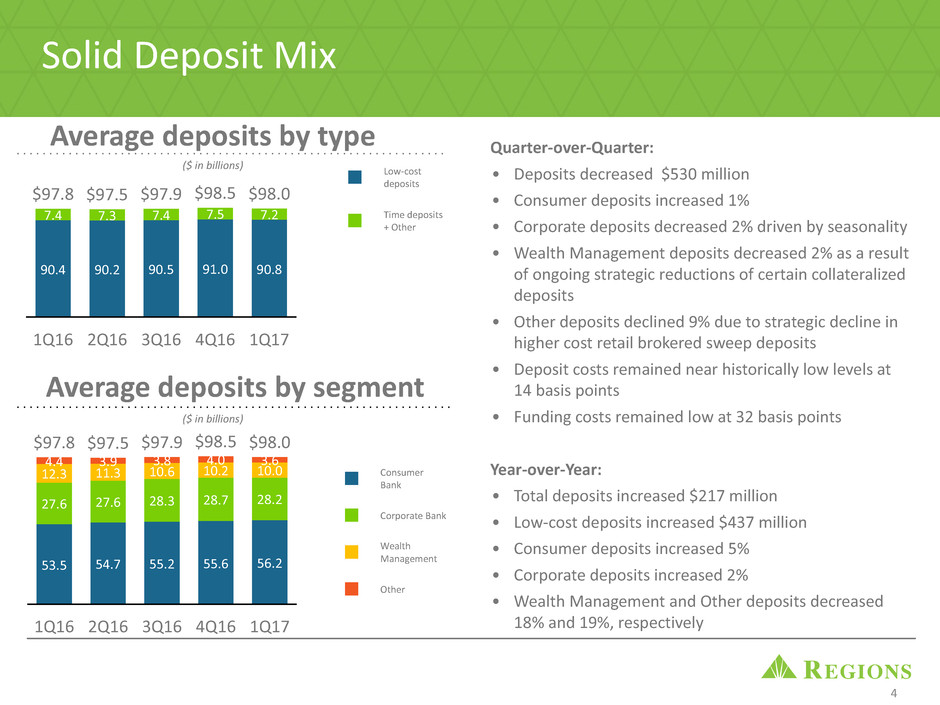
Average deposits by type Quarter-over-Quarter: • Deposits decreased $530 million • Consumer deposits increased 1% • Corporate deposits decreased 2% driven by seasonality • Wealth Management deposits decreased 2% as a result of ongoing strategic reductions of certain collateralized deposits • Other deposits declined 9% due to strategic decline in higher cost retail brokered sweep deposits • Deposit costs remained near historically low levels at 14 basis points • Funding costs remained low at 32 basis points Year-over-Year: • Total deposits increased $217 million • Low-cost deposits increased $437 million • Consumer deposits increased 5% • Corporate deposits increased 2% • Wealth Management and Other deposits decreased 18% and 19%, respectively Solid Deposit Mix Low-cost deposits Time deposits + Other 1Q16 2Q16 3Q16 4Q16 1Q17 90.4 90.2 90.5 91.0 90.8 7.4 $97.8 7.3 $97.5 7.4 $97.9 7.5 $98.5 7.2 $98.0 ($ in billions) 4 ($ in billions) Average deposits by segment Consumer Bank Corporate Bank Wealth Management Other 1Q16 2Q16 3Q16 4Q16 1Q17 53.5 54.7 55.2 55.6 56.2 27.6 27.6 28.3 28.7 28.2 12.3 11.3 10.6 10.2 10.0 4.4 $97.8 3.9 $97.5 3.8 $97.9 4.0 $98.5 3.6 $98.0
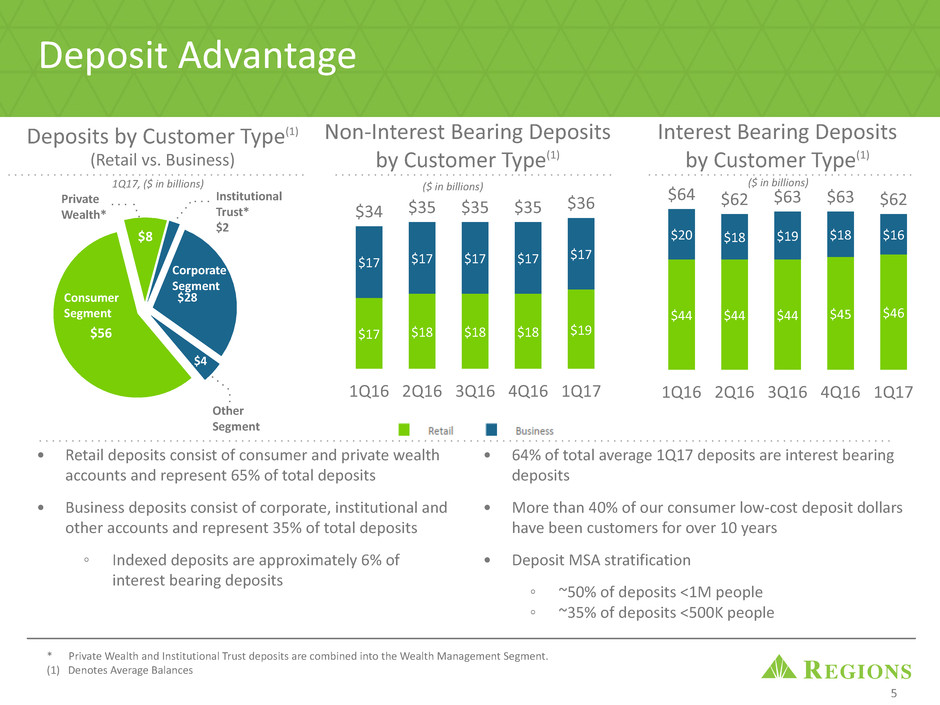
$56 $8 $28 $4 Other Segment Deposit Advantage Non-Interest Bearing Deposits by Customer Type(1) Deposits by Customer Type(1) (Retail vs. Business) • Retail deposits consist of consumer and private wealth accounts and represent 65% of total deposits • Business deposits consist of corporate, institutional and other accounts and represent 35% of total deposits ◦ Indexed deposits are approximately 6% of interest bearing deposits • 64% of total average 1Q17 deposits are interest bearing deposits • More than 40% of our consumer low-cost deposit dollars have been customers for over 10 years • Deposit MSA stratification ◦ ~50% of deposits <1M people ◦ ~35% of deposits <500K people Interest Bearing Deposits by Customer Type(1) 1Q16 2Q16 3Q16 4Q16 1Q17 $17 $18 $18 $18 $19 $17 $34 $17 $35 $17 $35 $17 $35 $17 $36 1Q16 2Q16 3Q16 4Q16 1Q17 $44 $44 $44 $45 $46 $20 $64 $18 $62 $19 $63 $18 $63 $16 $62 5 Consumer Segment Private Wealth* Corporate Segment Institutional Trust* $2 * Private Wealth and Institutional Trust deposits are combined into the Wealth Management Segment. (1) Denotes Average Balances ($ in billions)1Q17, ($ in billions) ($ in billions)
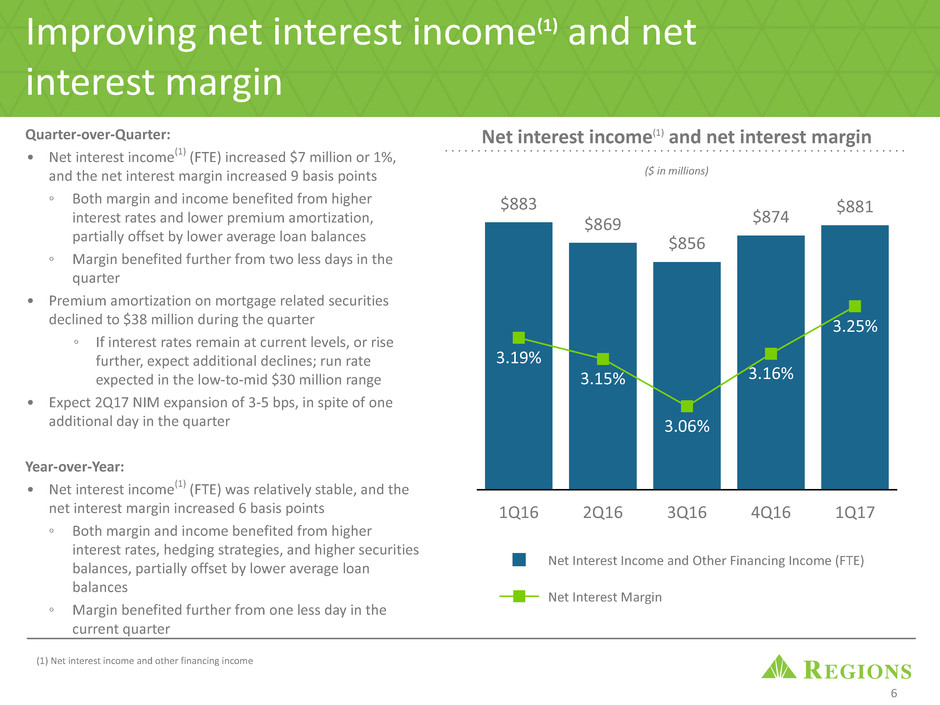
Improving net interest income(1) and net interest margin Net Interest Income and Other Financing Income (FTE) Net Interest Margin 1Q16 2Q16 3Q16 4Q16 1Q17 $883 $869 $856 $874 $881 3.19% 3.15% 3.06% 3.16% 3.25% Quarter-over-Quarter: • Net interest income(1) (FTE) increased $7 million or 1%, and the net interest margin increased 9 basis points ◦ Both margin and income benefited from higher interest rates and lower premium amortization, partially offset by lower average loan balances ◦ Margin benefited further from two less days in the quarter • Premium amortization on mortgage related securities declined to $38 million during the quarter ◦ If interest rates remain at current levels, or rise further, expect additional declines; run rate expected in the low-to-mid $30 million range • Expect 2Q17 NIM expansion of 3-5 bps, in spite of one additional day in the quarter Year-over-Year: • Net interest income(1) (FTE) was relatively stable, and the net interest margin increased 6 basis points ◦ Both margin and income benefited from higher interest rates, hedging strategies, and higher securities balances, partially offset by lower average loan balances ◦ Margin benefited further from one less day in the current quarter ($ in millions) 6 Net interest income(1) and net interest margin (1) Net interest income and other financing income
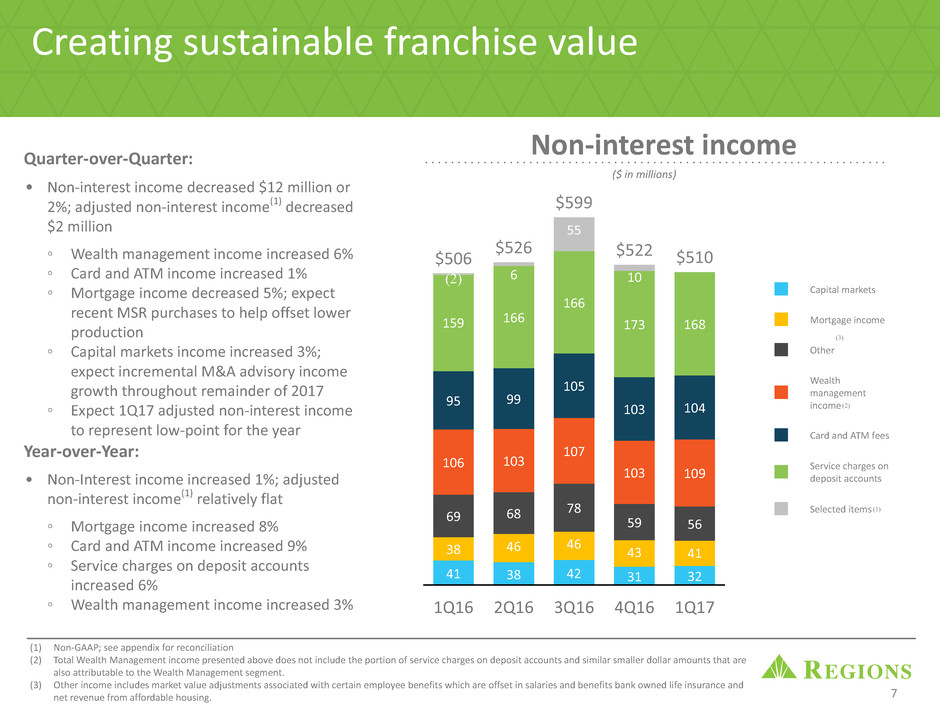
Creating sustainable franchise value (1) Non-GAAP; see appendix for reconciliation (2) Total Wealth Management income presented above does not include the portion of service charges on deposit accounts and similar smaller dollar amounts that are also attributable to the Wealth Management segment. (3) Other income includes market value adjustments associated with certain employee benefits which are offset in salaries and benefits bank owned life insurance and net revenue from affordable housing. Quarter-over-Quarter: • Non-interest income decreased $12 million or 2%; adjusted non-interest income(1) decreased $2 million ◦ Wealth management income increased 6% ◦ Card and ATM income increased 1% ◦ Mortgage income decreased 5%; expect recent MSR purchases to help offset lower production ◦ Capital markets income increased 3%; expect incremental M&A advisory income growth throughout remainder of 2017 ◦ Expect 1Q17 adjusted non-interest income to represent low-point for the year Year-over-Year: • Non-Interest income increased 1%; adjusted non-interest income(1) relatively flat ◦ Mortgage income increased 8% ◦ Card and ATM income increased 9% ◦ Service charges on deposit accounts increased 6% ◦ Wealth management income increased 3% ($ in millions) 7 Non-interest income Capital markets Mortgage income Other Wealth management income Card and ATM fees Service charges on deposit accounts Selected items 1Q16 2Q16 3Q16 4Q16 1Q17 41 38 42 31 32 38 46 46 43 41 69 68 78 59 56 106 103 107 103 109 95 99 105 103 104 159 $506 166 166 173 168 $510 6 $526 55 $599 10 $522 (2) (3) (2) (1)
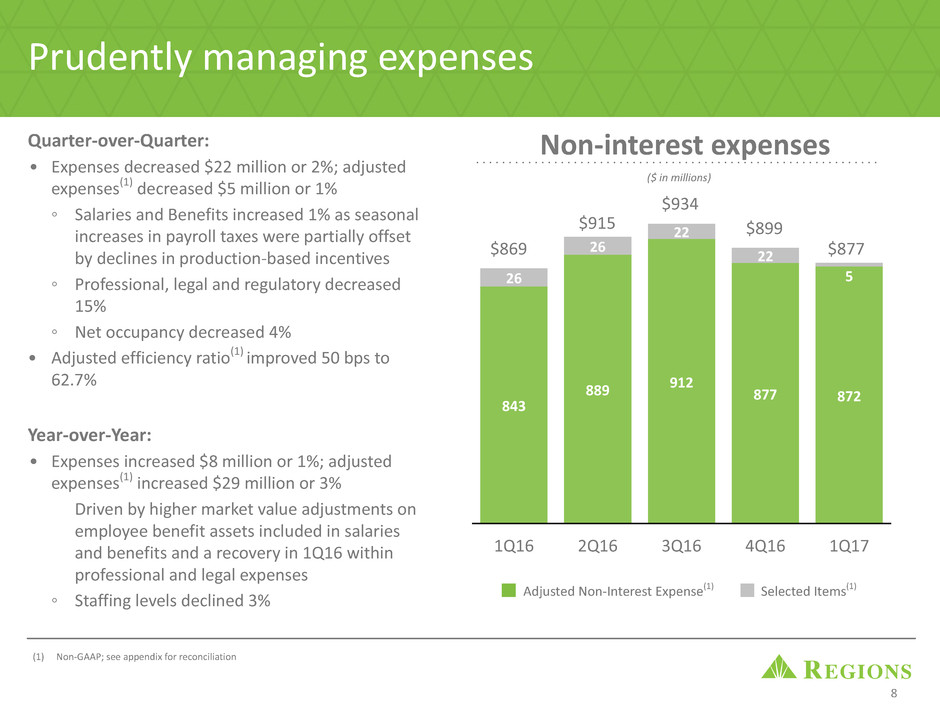
Prudently managing expenses 1Q16 2Q16 3Q16 4Q16 1Q17 843 889 912 877 872 26 26 22 22 5 1,754 Quarter-over-Quarter: • Expenses decreased $22 million or 2%; adjusted expenses(1) decreased $5 million or 1% ◦ Salaries and Benefits increased 1% as seasonal increases in payroll taxes were partially offset by declines in production-based incentives ◦ Professional, legal and regulatory decreased 15% ◦ Net occupancy decreased 4% • Adjusted efficiency ratio(1) improved 50 bps to 62.7% Year-over-Year: • Expenses increased $8 million or 1%; adjusted expenses(1) increased $29 million or 3% Driven by higher market value adjustments on employee benefit assets included in salaries and benefits and a recovery in 1Q16 within professional and legal expenses ◦ Staffing levels declined 3% (1) Non-GAAP; see appendix for reconciliation ($ in millions) Selected Items(1)Adjusted Non-Interest Expense(1) $869 $915 8 $934 26 $899 $877 Non-interest expenses 5
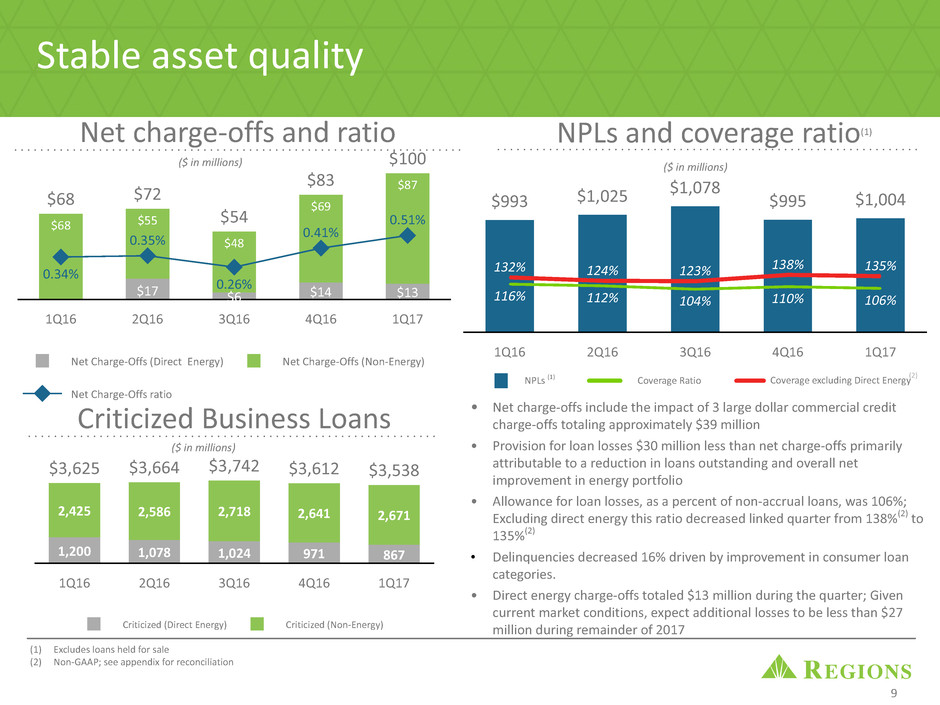
1Q16 2Q16 3Q16 4Q16 1Q17 $993 $1,025 $1,078 $995 $1,004 116% 112% 104% 110% 106% 132% 124% 123% 138% 135% Coverage excluding Direct Energy Stable asset quality • Net charge-offs include the impact of 3 large dollar commercial credit charge-offs totaling approximately $39 million • Provision for loan losses $30 million less than net charge-offs primarily attributable to a reduction in loans outstanding and overall net improvement in energy portfolio • Allowance for loan losses, as a percent of non-accrual loans, was 106%; Excluding direct energy this ratio decreased linked quarter from 138%(2) to 135%(2) • Delinquencies decreased 16% driven by improvement in consumer loan categories. • Direct energy charge-offs totaled $13 million during the quarter; Given current market conditions, expect additional losses to be less than $27 million during remainder of 2017 Criticized (Direct Energy) Criticized (Non-Energy) 1Q16 2Q16 3Q16 4Q16 1Q17 1,200 1,078 1,024 971 867 2,425 $3,625 2,586 $3,664 2,718 $3,742 2,641 $3,612 2,671 $3,538 NPLs and coverage ratio(1) ($ in millions) ($ in millions) ($ in millions) 9 Criticized Business Loans (1) Excludes loans held for sale (2) Non-GAAP; see appendix for reconciliation Net charge-offs and ratio (2) $69 $48 $55$68 $87 $6 NPLs (1) Coverage Ratio Net Charge-Offs (Direct Energy) Net Charge-Offs (Non-Energy) Net Charge-Offs ratio 1Q16 2Q16 3Q16 4Q16 1Q17 $17 $6 $14 $13 $68 $6 $55 $72 $48 $54 $69 $83 $87 $100 0.34% 0.35% 0.2 % 0.41% 0.51%
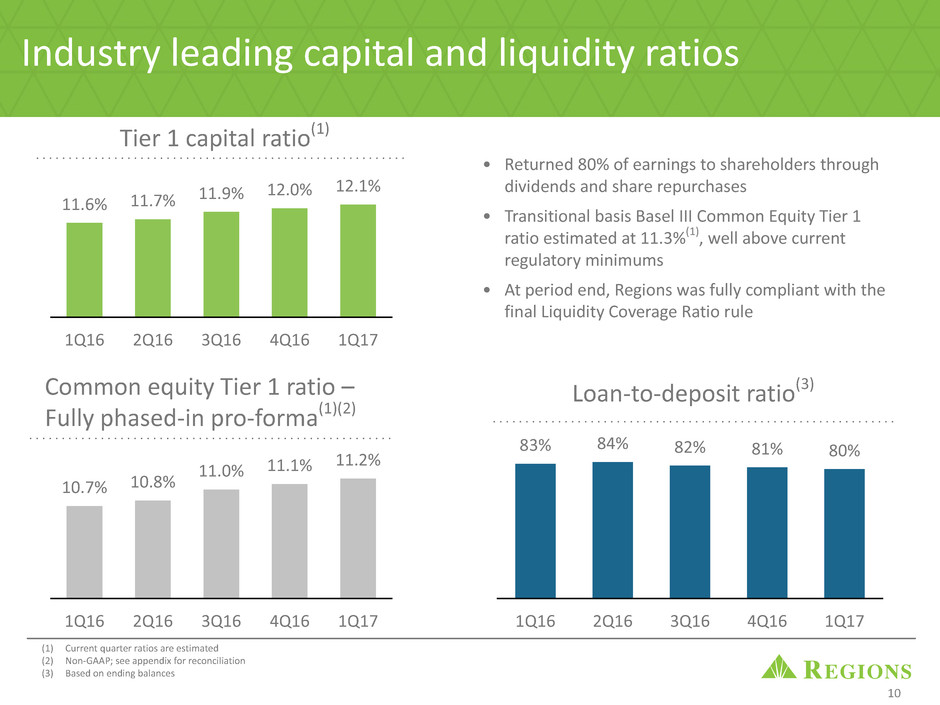
Industry leading capital and liquidity ratios • Returned 80% of earnings to shareholders through dividends and share repurchases • Transitional basis Basel III Common Equity Tier 1 ratio estimated at 11.3%(1), well above current regulatory minimums • At period end, Regions was fully compliant with the final Liquidity Coverage Ratio rule (1) Current quarter ratios are estimated (2) Non-GAAP; see appendix for reconciliation (3) Based on ending balances 10 Tier 1 capital ratio(1) Common equity Tier 1 ratio – Fully phased-in pro-forma(1)(2) Loan-to-deposit ratio(3) 1Q16 2Q16 3Q16 4Q16 1Q17 11.6% 11.7% 11.9% 12.0% 12.1% 1Q16 2Q16 3Q16 4Q16 1Q17 10.7% 10.8% 11.0% 11.1% 11.2% 1Q16 2Q16 3Q16 4Q16 1Q17 83% 84% 82% 81% 80%
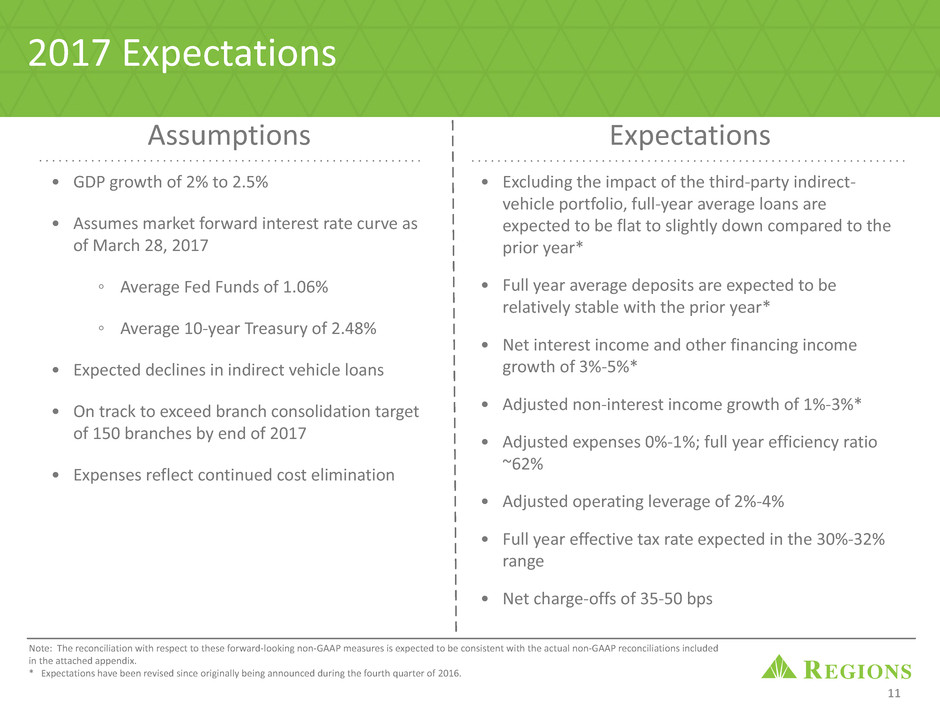
2017 Expectations 11 Assumptions Expectations • GDP growth of 2% to 2.5% • Assumes market forward interest rate curve as of March 28, 2017 ◦ Average Fed Funds of 1.06% ◦ Average 10-year Treasury of 2.48% • Expected declines in indirect vehicle loans • On track to exceed branch consolidation target of 150 branches by end of 2017 • Expenses reflect continued cost elimination • Excluding the impact of the third-party indirect- vehicle portfolio, full-year average loans are expected to be flat to slightly down compared to the prior year* • Full year average deposits are expected to be relatively stable with the prior year* • Net interest income and other financing income growth of 3%-5%* • Adjusted non-interest income growth of 1%-3%* • Adjusted expenses 0%-1%; full year efficiency ratio ~62% • Adjusted operating leverage of 2%-4% • Full year effective tax rate expected in the 30%-32% range • Net charge-offs of 35-50 bps Note: The reconciliation with respect to these forward-looking non-GAAP measures is expected to be consistent with the actual non-GAAP reconciliations included in the attached appendix. * Expectations have been revised since originally being announced during the fourth quarter of 2016.

Appendix 12
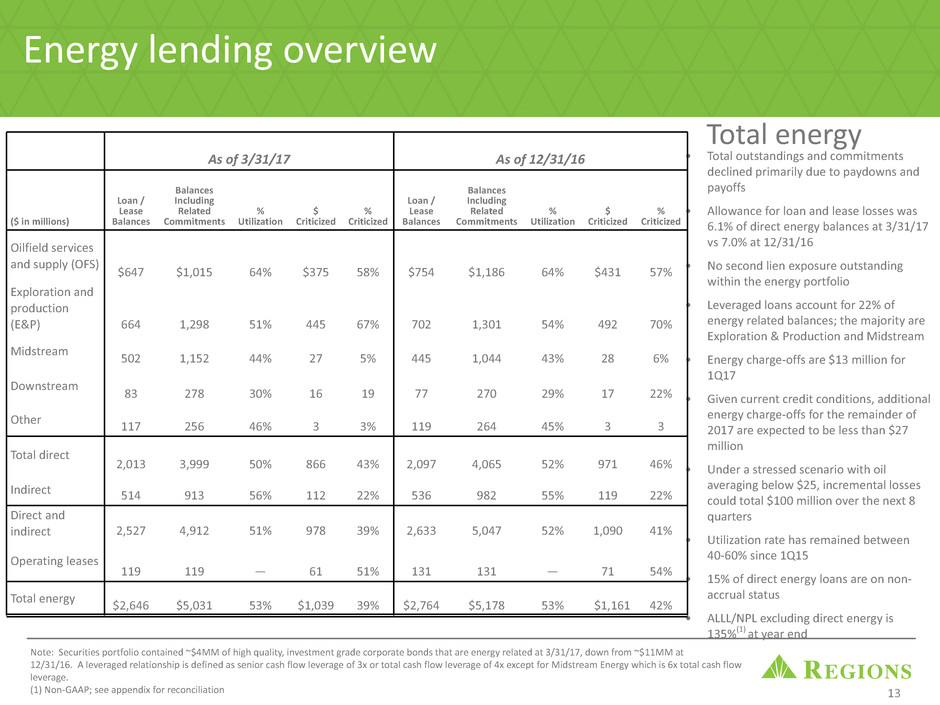
• Total outstandings and commitments declined primarily due to paydowns and payoffs • Allowance for loan and lease losses was 6.1% of direct energy balances at 3/31/17 vs 7.0% at 12/31/16 • No second lien exposure outstanding within the energy portfolio • Leveraged loans account for 22% of energy related balances; the majority are Exploration & Production and Midstream • Energy charge-offs are $13 million for 1Q17 • Given current credit conditions, additional energy charge-offs for the remainder of 2017 are expected to be less than $27 million • Under a stressed scenario with oil averaging below $25, incremental losses could total $100 million over the next 8 quarters • Utilization rate has remained between 40-60% since 1Q15 • 15% of direct energy loans are on non- accrual status • ALLL/NPL excluding direct energy is 135%(1) at year end Energy lending overview Total energy As of 3/31/17 As of 12/31/16 ($ in millions) Loan / Lease Balances Balances Including Related Commitments % Utilization $ Criticized % Criticized Loan / Lease Balances Balances Including Related Commitments % Utilization $ Criticized % Criticized Oilfield services and supply (OFS) $647 $1,015 64% $375 58% $754 $1,186 64% $431 57% Exploration and production (E&P) 664 1,298 51% 445 67% 702 1,301 54% 492 70% Midstream 502 1,152 44% 27 5% 445 1,044 43% 28 6% Downstream 83 278 30% 16 19 77 270 29% 17 22% Other 117 256 46% 3 3% 119 264 45% 3 3 Total direct 2,013 3,999 50% 866 43% 2,097 4,065 52% 971 46% Indirect 514 913 56% 112 22% 536 982 55% 119 22% Direct and indirect 2,527 4,912 51% 978 39% 2,633 5,047 52% 1,090 41% Operating leases 119 119 — 61 51% 131 131 — 71 54% Total energy $2,646 $5,031 53% $1,039 39% $2,764 $5,178 53% $1,161 42% Note: Securities portfolio contained ~$4MM of high quality, investment grade corporate bonds that are energy related at 3/31/17, down from ~$11MM at 12/31/16. A leveraged relationship is defined as senior cash flow leverage of 3x or total cash flow leverage of 4x except for Midstream Energy which is 6x total cash flow leverage. (1) Non-GAAP; see appendix for reconciliation 13
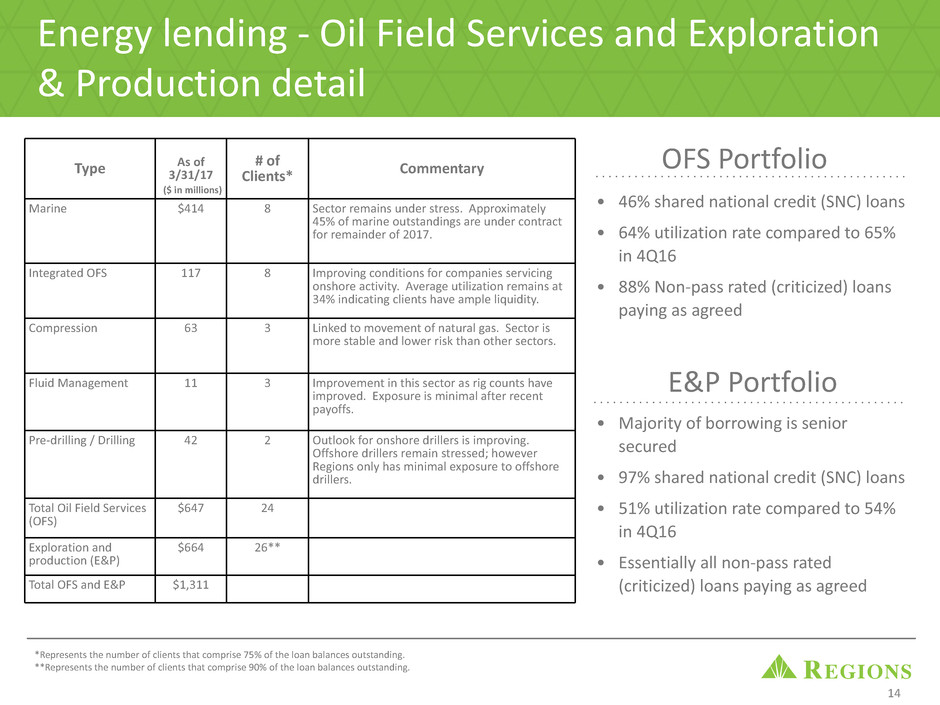
Energy lending - Oil Field Services and Exploration & Production detail Type As of3/31/17 # of Clients* Commentary Marine $414 8 Sector remains under stress. Approximately 45% of marine outstandings are under contract for remainder of 2017. Integrated OFS 117 8 Improving conditions for companies servicing onshore activity. Average utilization remains at 34% indicating clients have ample liquidity. Compression 63 3 Linked to movement of natural gas. Sector is more stable and lower risk than other sectors. Fluid Management 11 3 Improvement in this sector as rig counts have improved. Exposure is minimal after recent payoffs. Pre-drilling / Drilling 42 2 Outlook for onshore drillers is improving. Offshore drillers remain stressed; however Regions only has minimal exposure to offshore drillers. Total Oil Field Services (OFS) $647 24 Exploration and production (E&P) $664 26** Total OFS and E&P $1,311 • 46% shared national credit (SNC) loans • 64% utilization rate compared to 65% in 4Q16 • 88% Non-pass rated (criticized) loans paying as agreed E&P Portfolio *Represents the number of clients that comprise 75% of the loan balances outstanding. **Represents the number of clients that comprise 90% of the loan balances outstanding. OFS Portfolio 14 • Majority of borrowing is senior secured • 97% shared national credit (SNC) loans • 51% utilization rate compared to 54% in 4Q16 • Essentially all non-pass rated (criticized) loans paying as agreed ($ in millions)
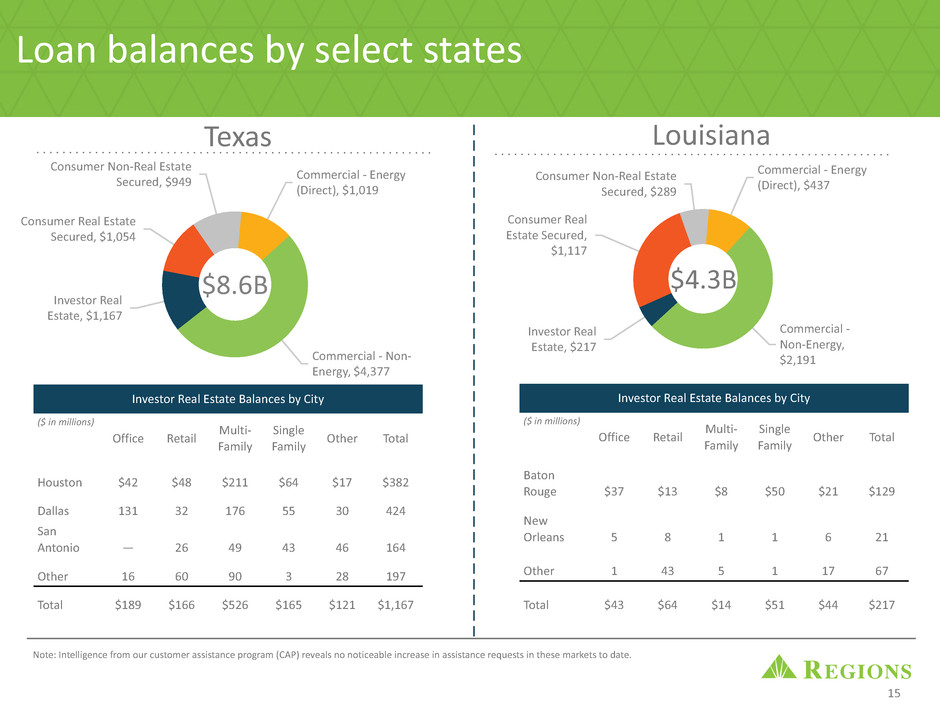
Commercial - Non-Energy, $2,191 Investor Real Estate, $217 Consumer Real Estate Secured, $1,117 Consumer Non-Real Estate Secured, $289 Commercial - Energy (Direct), $437 Loan balances by select states Texas Louisiana Note: Intelligence from our customer assistance program (CAP) reveals no noticeable increase in assistance requests in these markets to date. Commercial - Non- Energy, $4,377 Investor Real Estate, $1,167 Consumer Real Estate Secured, $1,054 Consumer Non-Real Estate Secured, $949 Commercial - Energy (Direct), $1,019 Investor Real Estate Balances by City ($ in millions) Office Retail Multi-Family Single Family Other Total Houston $42 $48 $211 $64 $17 $382 Dallas 131 32 176 55 30 424 San Antonio — 26 49 43 46 164 Other 16 60 90 3 28 197 Total $189 $166 $526 $165 $121 $1,167 Investor Real Estate Balances by City ($ in millions) Office Retail Multi-Family Single Family Other Total Baton Rouge $37 $13 $8 $50 $21 $129 New Orleans 5 8 1 1 6 21 Other 1 43 5 1 17 67 Total $43 $64 $14 $51 $44 $217 15 $4.3B$8.6B
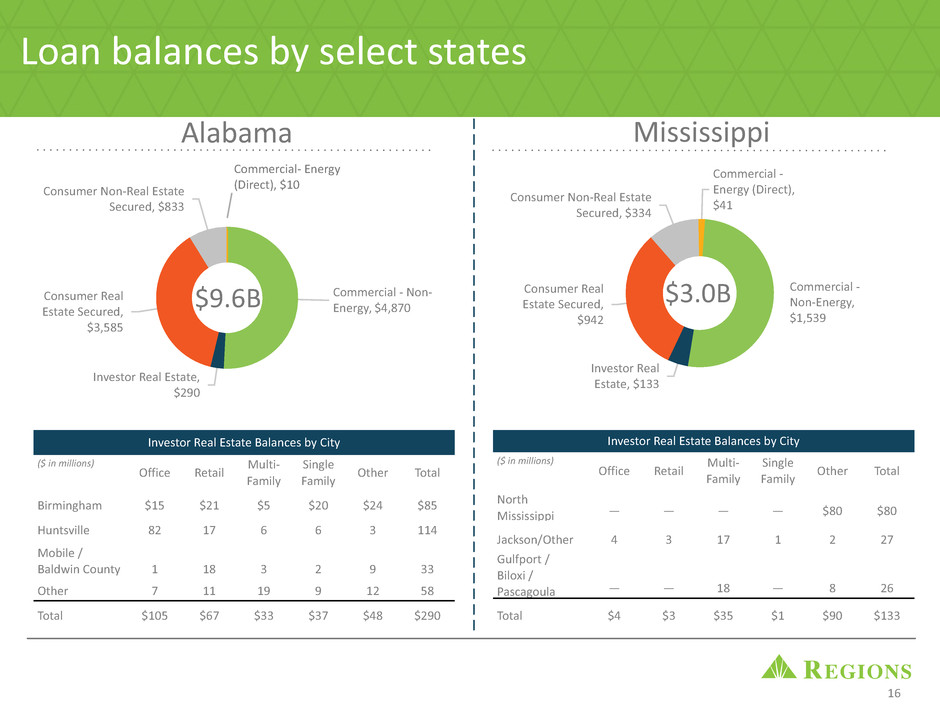
Loan balances by select states Alabama Mississippi Commercial - Non- Energy, $4,870 Investor Real Estate, $290 Consumer Real Estate Secured, $3,585 Consumer Non-Real Estate Secured, $833 Commercial - Non-Energy, $1,539 Investor Real Estate, $133 Consumer Real Estate Secured, $942 Consumer Non-Real Estate Secured, $334 Commercial - Energy (Direct), $41 16 $3.0B$9.6B Investor Real Estate Balances by City ($ in millions) Office Retail Multi- Family Single Family Other Total Birmingham $15 $21 $5 $20 $24 $85 Huntsville 82 17 6 6 3 114 Mobile / Baldwin County 1 18 3 2 9 33 Other 7 11 19 9 12 58 Total $105 $67 $33 $37 $48 $290 Investor Real Estate Balances by City ($ in millions) Office Retail Multi-Family Single Family Other Total North Mississippi — — — — $80 $80 Jackson/Other 4 3 17 1 2 27 Gulfport / Biloxi / Pascagoula — — 18 — 8 26 Total $4 $3 $35 $1 $90 $133 Commercial- Energy (Direct), $10

Non-GAAP reconciliation: Non-interest income, non-interest expense and efficiency ratio NM - Not Meaningful 17 The table below presents computations of the efficiency ratio (non-GAAP), which is a measure of productivity, generally calculated as non-interest expense divided by total revenue. Management uses this ratio to monitor performance and believes this measure provides meaningful information to investors. Non-interest expense (GAAP) is presented excluding certain adjustments to arrive at adjusted non-interest expense (non-GAAP), which is the numerator for the efficiency ratio. Non-interest income (GAAP) is presented excluding certain adjustments to arrive at adjusted non-interest income (non-GAAP), which is the numerator for the fee income ratio. Net interest income and other financing income on a taxable-equivalent basis and non-interest income are added together to arrive at total revenue on a taxable-equivalent basis. Adjustments are made to arrive at adjusted total revenue on a taxable-equivalent basis (non-GAAP), which is the denominator for the efficiency ratio. Regions believes that the exclusion of these adjustments provides a meaningful base for period-to-period comparisons, which management believes will assist investors in analyzing the operating results of the Company and predicting future performance. These non-GAAP financial measures are also used by management to assess the performance of Regions’ business. It is possible that the activities related to the adjustments may recur; however, management does not consider the activities related to the adjustments to be indications of ongoing operations. The table on the following page presents a computation of the operating leverage ratio (non-GAAP) which is the period to period percentage change in adjusted total revenue on a taxable-equivalent basis (non- GAAP) less the percentage change in adjusted non-interest expense (non-GAAP). Regions believes that presentation of these non-GAAP financial measures will permit investors to assess the performance of the Company on the same basis as that applied by management. Quarter Ended ($ amounts in millions) 3/31/2017 12/31/2016 9/30/2016 6/30/2016 3/31/2016 1Q17 vs. 4Q16 1Q17 vs. 1Q16 ADJUSTED EFFICIENCY, FEE INCOME AND OPERATING LEVERAGE RATIOS, ADJUSTED NON-INTEREST INCOME/EXPENSE-CONTINUING OPERATIONS Non-interest expense (GAAP) A $ 877 $ 899 $ 934 $ 915 $ 869 $ (22) (2.4)% $ 8 0.9 % Adjustments: Professional, legal and regulatory expenses — — — (3) — — NM — NM Branch consolidation, property and equipment charges (1) (17) (5) (22) (14) 16 (94.1)% 13 (92.9)% Loss on early extinguishment of debt — — (14) — — — NM — NM Salary and employee benefits—severance charges (4) (5) (3) (1) (12) 1 (20.0)% 8 (66.7)% Adjusted non-interest expense (non-GAAP) B $ 872 $ 877 $ 912 $ 889 $ 843 $ (5) (0.6)% $ 29 3.4 % Net interest income and other financing income (GAAP) $ 859 $ 853 $ 835 $ 848 $ 862 $ 6 0.7 % $ (3) (0.3)% Taxable-equivalent adjustment 22 21 21 21 21 1 4.8 % 1 4.8 % Net interest income and other financing income, taxable-equivalent basis C $ 881 $ 874 $ 856 $ 869 $ 883 $ 7 0.8 % $ (2) (0.2)% Non-interest income (GAAP) D $ 510 $ 522 $ 599 $ 526 $ 506 $ (12) (2.3)% $ 4 0.8 % Adjustments: Securities (gains) losses, net — (5) — (6) 5 5 (100.0)% (5) (100.0)% Insurance proceeds — — (47) — (3) — NM 3 (100.0)% Leveraged lease termination gains, net — — (8) — — — NM — NM Gain on sale of affordable housing residential mortgage loans — (5) — — — 5 (100.0)% — NM Adjusted non-interest income (non-GAAP) E $ 510 $ 512 $ 544 $ 520 $ 508 $ (2) (0.4)% $ 2 0.4 % Total revenue, taxable-equivalent basis C+D=F $ 1,391 $ 1,396 $ 1,455 $ 1,395 $ 1,389 $ (5) (0.4)% $ 2 0.1 % Adjusted total revenue, taxable-equivalent basis (non-GAAP) C+E=G $ 1,391 $ 1,386 $ 1,400 $ 1,389 $ 1,391 $ 5 0.4 % $ — — % Operating leverage ratio (GAAP) F-A (0.8)% Adjusted operating leverage ratio (non-GAAP) G-B (3.4)% Efficiency ratio (GAAP) A/F 63.1% 64.4% 64.2% 65.6% 62.5% Adjusted efficiency ratio (non-GAAP) B/G 62.7% 63.2% 65.3% 64.0% 60.6% Fee income ratio (GAAP) D/F 36.7% 37.4% 41.2% 37.7% 36.4% Adjusted fee income ratio (non-GAAP) E/G 36.6% 36.9% 38.8% 37.5% 36.5%
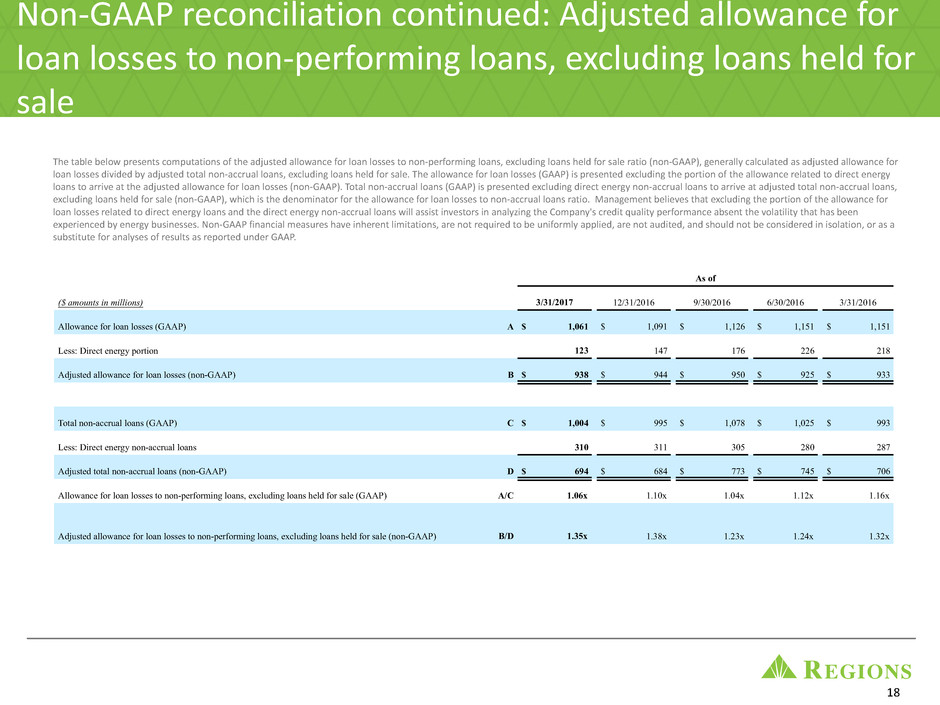
The table below presents computations of the adjusted allowance for loan losses to non-performing loans, excluding loans held for sale ratio (non-GAAP), generally calculated as adjusted allowance for loan losses divided by adjusted total non-accrual loans, excluding loans held for sale. The allowance for loan losses (GAAP) is presented excluding the portion of the allowance related to direct energy loans to arrive at the adjusted allowance for loan losses (non-GAAP). Total non-accrual loans (GAAP) is presented excluding direct energy non-accrual loans to arrive at adjusted total non-accrual loans, excluding loans held for sale (non-GAAP), which is the denominator for the allowance for loan losses to non-accrual loans ratio. Management believes that excluding the portion of the allowance for loan losses related to direct energy loans and the direct energy non-accrual loans will assist investors in analyzing the Company's credit quality performance absent the volatility that has been experienced by energy businesses. Non-GAAP financial measures have inherent limitations, are not required to be uniformly applied, are not audited, and should not be considered in isolation, or as a substitute for analyses of results as reported under GAAP. Non-GAAP reconciliation continued: Adjusted allowance for loan losses to non-performing loans, excluding loans held for sale 18 As of ($ amounts in millions) 3/31/2017 12/31/2016 9/30/2016 6/30/2016 3/31/2016 Allowance for loan losses (GAAP) A $ 1,061 $ 1,091 $ 1,126 $ 1,151 $ 1,151 Less: Direct energy portion 123 147 176 226 218 Adjusted allowance for loan losses (non-GAAP) B $ 938 $ 944 $ 950 $ 925 $ 933 Total non-accrual loans (GAAP) C $ 1,004 $ 995 $ 1,078 $ 1,025 $ 993 Less: Direct energy non-accrual loans 310 311 305 280 287 Adjusted total non-accrual loans (non-GAAP) D $ 694 $ 684 $ 773 $ 745 $ 706 Allowance for loan losses to non-performing loans, excluding loans held for sale (GAAP) A/C 1.06x 1.10x 1.04x 1.12x 1.16x Adjusted allowance for loan losses to non-performing loans, excluding loans held for sale (non-GAAP) B/D 1.35x 1.38x 1.23x 1.24x 1.32x

Non-GAAP reconciliation: Basel III common equity Tier 1 ratio – fully phased-in pro-forma (1) Current quarter amounts and the resulting ratio are estimated. (2) Regions continues to develop systems and internal controls to precisely calculate risk-weighted assets as required by Basel III on a fully phased-in basis. The amount included above is a reasonable approximation, based on our understanding of the requirements. 19 The calculation of the fully phased-in pro-forma "Common equity Tier 1" (CET1) is based on Regions’ understanding of the Final Basel III requirements. For Regions, the Basel III framework became effective on a phased-in approach starting in 2015 with full implementation beginning in 2019. The calculation provided below includes estimated pro-forma amounts for the ratio on a fully phased-in basis. Regions’ current understanding of the final framework includes certain assumptions, including the Company’s interpretation of the requirements, and informal feedback received through the regulatory process. Regions’ understanding of the framework is evolving and will likely change as analysis and discussions with regulators continue. Because Regions is not currently subject to the fully- phased in capital rules, this pro-forma measure is considered to be a non-GAAP financial measure, and other entities may calculate it differently from Regions’ disclosed calculation. A company's regulatory capital is often expressed as a percentage of risk-weighted assets. Under the risk-based capital framework, a company’s balance sheet assets and credit equivalent amounts of off-balance sheet items are assigned to broad risk categories. The aggregated dollar amount in each category is then multiplied by the prescribed risk-weighted percentage. The resulting weighted values from each of the categories are added together and this sum is the risk-weighted assets total that, as adjusted, comprises the denominator of certain risk-based capital ratios. Common equity Tier 1 capital is then divided by this denominator (risk-weighted assets) to determine the common equity Tier 1 capital ratio. The amounts disclosed as risk-weighted assets are calculated consistent with banking regulatory requirements on a fully phased-in basis. Since analysts and banking regulators may assess Regions’ capital adequacy using the fully phased-in Basel III framework, we believe that it is useful to provide investors the ability to assess Regions’ capital adequacy on this same basis. ($ amounts in millions) 3/31/2017 12/31/2016 9/30/2016 6/30/2016 3/31/2016 Basel III Common Equity Tier 1 Ratio—Fully Phased-In Pro-Forma (1) Stockholder's equity (GAAP) $ 16,722 $ 16,664 $ 17,365 $ 17,385 $ 17,211 Non-qualifying goodwill and intangibles (4,943) (4,955) (4,936) (4,946) (4,947) Adjustments, including all components of accumulated other comprehensive income, disallowed deferred tax assets, threshold deductions and other adjustments 504 489 (173) (227) (64) Preferred stock (GAAP) (820) (820) (820) (820) (820) Basel III common equity Tier 1—Fully Phased-In Pro-Forma (non-GAAP) D $ 11,463 $ 11,378 $ 11,436 $ 11,392 $ 11,380 Basel III risk-weighted assets—Fully Phased-In Pro-Forma (non-GAAP) (2) E $ 102,551 $ 102,975 $ 103,749 $ 105,199 $ 106,227 Basel III common equity Tier 1 ratio—Fully Phased-In Pro-Forma (non-GAAP) D/E 11.2% 11.1% 11.0% 10.8% 10.7 %
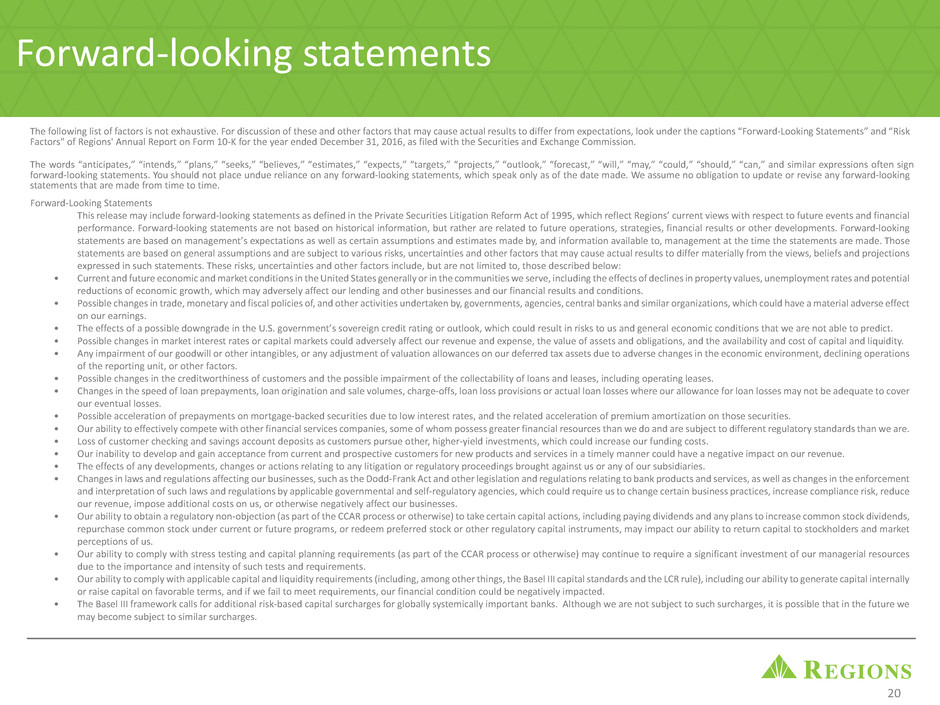
Forward-looking statements 20 Forward-Looking Statements This release may include forward-looking statements as defined in the Private Securities Litigation Reform Act of 1995, which reflect Regions’ current views with respect to future events and financial performance. Forward-looking statements are not based on historical information, but rather are related to future operations, strategies, financial results or other developments. Forward-looking statements are based on management’s expectations as well as certain assumptions and estimates made by, and information available to, management at the time the statements are made. Those statements are based on general assumptions and are subject to various risks, uncertainties and other factors that may cause actual results to differ materially from the views, beliefs and projections expressed in such statements. These risks, uncertainties and other factors include, but are not limited to, those described below: • Current and future economic and market conditions in the United States generally or in the communities we serve, including the effects of declines in property values, unemployment rates and potential reductions of economic growth, which may adversely affect our lending and other businesses and our financial results and conditions. • Possible changes in trade, monetary and fiscal policies of, and other activities undertaken by, governments, agencies, central banks and similar organizations, which could have a material adverse effect on our earnings. • The effects of a possible downgrade in the U.S. government’s sovereign credit rating or outlook, which could result in risks to us and general economic conditions that we are not able to predict. • Possible changes in market interest rates or capital markets could adversely affect our revenue and expense, the value of assets and obligations, and the availability and cost of capital and liquidity. • Any impairment of our goodwill or other intangibles, or any adjustment of valuation allowances on our deferred tax assets due to adverse changes in the economic environment, declining operations of the reporting unit, or other factors. • Possible changes in the creditworthiness of customers and the possible impairment of the collectability of loans and leases, including operating leases. • Changes in the speed of loan prepayments, loan origination and sale volumes, charge-offs, loan loss provisions or actual loan losses where our allowance for loan losses may not be adequate to cover our eventual losses. • Possible acceleration of prepayments on mortgage-backed securities due to low interest rates, and the related acceleration of premium amortization on those securities. • Our ability to effectively compete with other financial services companies, some of whom possess greater financial resources than we do and are subject to different regulatory standards than we are. • Loss of customer checking and savings account deposits as customers pursue other, higher-yield investments, which could increase our funding costs. • Our inability to develop and gain acceptance from current and prospective customers for new products and services in a timely manner could have a negative impact on our revenue. • The effects of any developments, changes or actions relating to any litigation or regulatory proceedings brought against us or any of our subsidiaries. • Changes in laws and regulations affecting our businesses, such as the Dodd-Frank Act and other legislation and regulations relating to bank products and services, as well as changes in the enforcement and interpretation of such laws and regulations by applicable governmental and self-regulatory agencies, which could require us to change certain business practices, increase compliance risk, reduce our revenue, impose additional costs on us, or otherwise negatively affect our businesses. • Our ability to obtain a regulatory non-objection (as part of the CCAR process or otherwise) to take certain capital actions, including paying dividends and any plans to increase common stock dividends, repurchase common stock under current or future programs, or redeem preferred stock or other regulatory capital instruments, may impact our ability to return capital to stockholders and market perceptions of us. • Our ability to comply with stress testing and capital planning requirements (as part of the CCAR process or otherwise) may continue to require a significant investment of our managerial resources due to the importance and intensity of such tests and requirements. • Our ability to comply with applicable capital and liquidity requirements (including, among other things, the Basel III capital standards and the LCR rule), including our ability to generate capital internally or raise capital on favorable terms, and if we fail to meet requirements, our financial condition could be negatively impacted. • The Basel III framework calls for additional risk-based capital surcharges for globally systemically important banks. Although we are not subject to such surcharges, it is possible that in the future we may become subject to similar surcharges. The following list of factors is not exhaustive. For discussion of these and other factors that may cause actual results to differ from expectations, look under the captions “Forward-Looking Statements” and “Risk Factors" of Regions' Annual Report on Form 10-K for the year ended December 31, 2016, as filed with the Securities and Exchange Commission. The words “anticipates,” “intends,” “plans,” “seeks,” “believes,” “estimates,” “expects,” “targets,” “projects,” “outlook,” “forecast,” “will,” “may,” “could,” “should,” “can,” and similar expressions often signify forward-looking statements. You should not place undue reliance on any forward-looking statements, which speak only as of the date made. We assume no obligation to update or revise any forward-looking statements that are made from time to time.
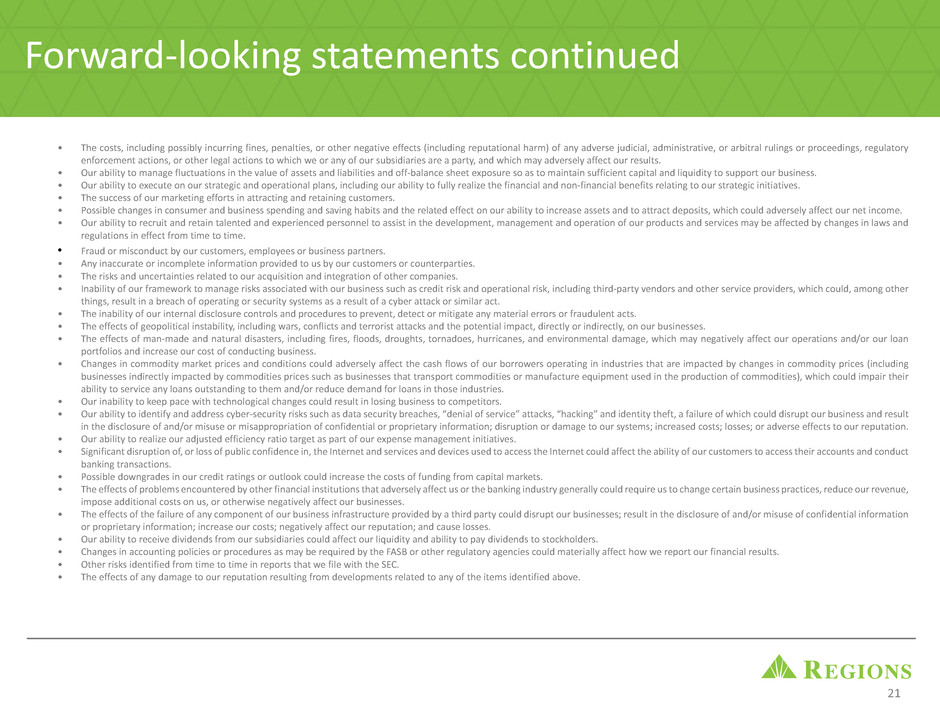
• The costs, including possibly incurring fines, penalties, or other negative effects (including reputational harm) of any adverse judicial, administrative, or arbitral rulings or proceedings, regulatory enforcement actions, or other legal actions to which we or any of our subsidiaries are a party, and which may adversely affect our results. • Our ability to manage fluctuations in the value of assets and liabilities and off-balance sheet exposure so as to maintain sufficient capital and liquidity to support our business. • Our ability to execute on our strategic and operational plans, including our ability to fully realize the financial and non-financial benefits relating to our strategic initiatives. • The success of our marketing efforts in attracting and retaining customers. • Possible changes in consumer and business spending and saving habits and the related effect on our ability to increase assets and to attract deposits, which could adversely affect our net income. • Our ability to recruit and retain talented and experienced personnel to assist in the development, management and operation of our products and services may be affected by changes in laws and regulations in effect from time to time. • Fraud or misconduct by our customers, employees or business partners. • Any inaccurate or incomplete information provided to us by our customers or counterparties. • The risks and uncertainties related to our acquisition and integration of other companies. • Inability of our framework to manage risks associated with our business such as credit risk and operational risk, including third-party vendors and other service providers, which could, among other things, result in a breach of operating or security systems as a result of a cyber attack or similar act. • The inability of our internal disclosure controls and procedures to prevent, detect or mitigate any material errors or fraudulent acts. • The effects of geopolitical instability, including wars, conflicts and terrorist attacks and the potential impact, directly or indirectly, on our businesses. • The effects of man-made and natural disasters, including fires, floods, droughts, tornadoes, hurricanes, and environmental damage, which may negatively affect our operations and/or our loan portfolios and increase our cost of conducting business. • Changes in commodity market prices and conditions could adversely affect the cash flows of our borrowers operating in industries that are impacted by changes in commodity prices (including businesses indirectly impacted by commodities prices such as businesses that transport commodities or manufacture equipment used in the production of commodities), which could impair their ability to service any loans outstanding to them and/or reduce demand for loans in those industries. • Our inability to keep pace with technological changes could result in losing business to competitors. • Our ability to identify and address cyber-security risks such as data security breaches, “denial of service” attacks, “hacking” and identity theft, a failure of which could disrupt our business and result in the disclosure of and/or misuse or misappropriation of confidential or proprietary information; disruption or damage to our systems; increased costs; losses; or adverse effects to our reputation. • Our ability to realize our adjusted efficiency ratio target as part of our expense management initiatives. • Significant disruption of, or loss of public confidence in, the Internet and services and devices used to access the Internet could affect the ability of our customers to access their accounts and conduct banking transactions. • Possible downgrades in our credit ratings or outlook could increase the costs of funding from capital markets. • The effects of problems encountered by other financial institutions that adversely affect us or the banking industry generally could require us to change certain business practices, reduce our revenue, impose additional costs on us, or otherwise negatively affect our businesses. • The effects of the failure of any component of our business infrastructure provided by a third party could disrupt our businesses; result in the disclosure of and/or misuse of confidential information or proprietary information; increase our costs; negatively affect our reputation; and cause losses. • Our ability to receive dividends from our subsidiaries could affect our liquidity and ability to pay dividends to stockholders. • Changes in accounting policies or procedures as may be required by the FASB or other regulatory agencies could materially affect how we report our financial results. • Other risks identified from time to time in reports that we file with the SEC. • The effects of any damage to our reputation resulting from developments related to any of the items identified above. Forward-looking statements continued 21

® 22





















